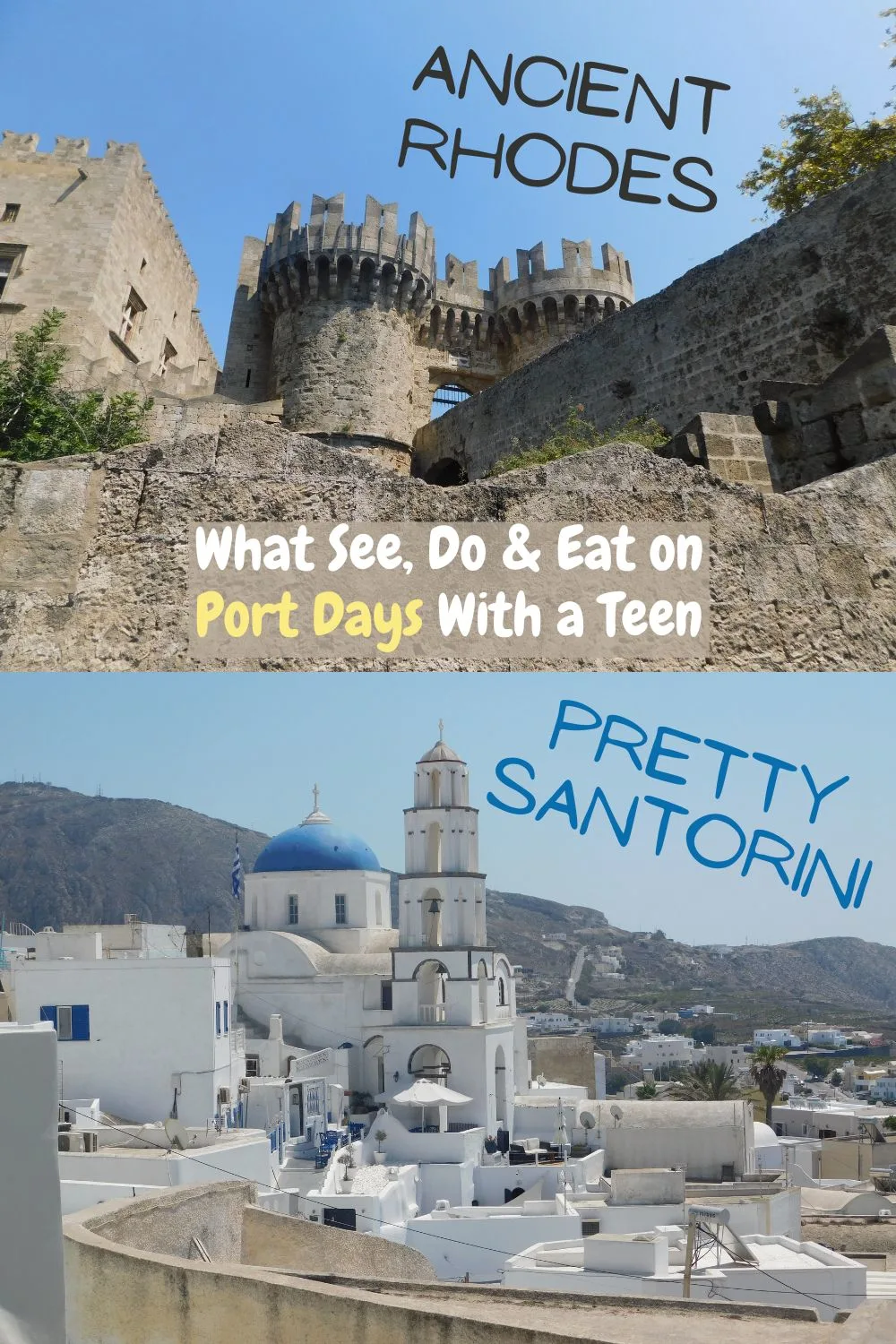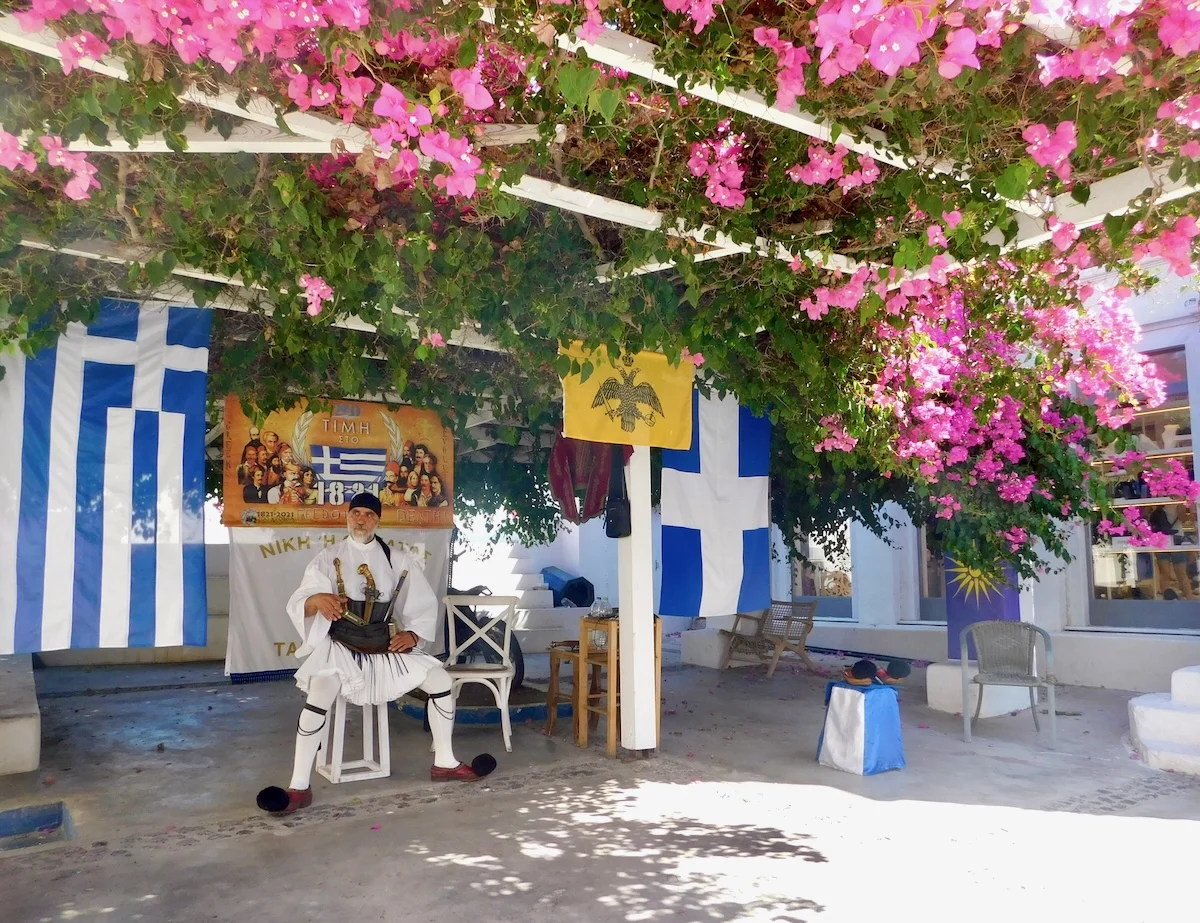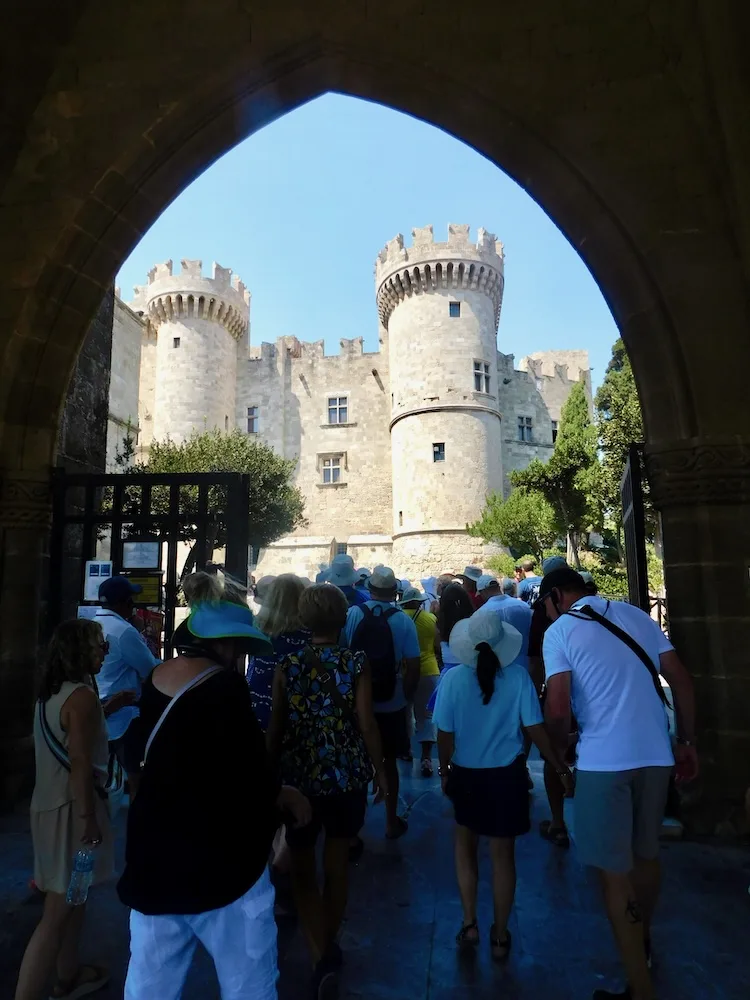The first things to know about your Santorini and Rhodes port days are that the former island is beautiful, and the latter is crammed with history. The second thing to know is that Santorini during the summer is hot and crowded. Very crowded. Very, very crowded. Rhodes is not quite as crowded, but it is very hot.
Nevertheless, we were charmed and impressed by two Greek islands during the port days on our Holland America cruise. Luckily, we had good tours, a teenager who was game to explore, and good insider tips from our cruise director, which helped us to make the most of our time at these popular Mediterranean cruise stops.
Here are some of the things we did right, and the one thing I did wrong, to help you plan your own perfect port days on Santorini and Rhodes.
Santorini and Rhodes Crib Notes
• We started our Holland America Cruise in Venice. We also stopped in Split and Korcula, Croatia. And we ended in Athens.
• We liked all of our Holland America tours, but if you want to go out on your own, you can my curated collections of Santorini and Rhodes port-day tours on Viator.
•If you stay overnight, look for a hotel with a pool on Santorini and opt for a beach resort in Rhodes.
• Scroll to the bottom to Print my Cruise Vacation Packing List
Unforgettable Things To Do, See & Eat on Your Santorini Port Day
The Blue Domes & Crowds of Oia
We wanted to spend our port day in Santorini wandering around gorgeous whitewashed towns, admiring the famous blue-domed roofs, shopping and eating fresh Greek food. And we wanted to explore the island at our own pace.
So I booked a taxi through a company called Welcome Pickups for four hours, which worked out well. The English-speaking driver picked us up in Fira shortly before 10:00, and we headed immediately to Oia (pronounced Eeya), a postcard-perfect town and the only place in Santorini more crowded than Fira (Santorini town).
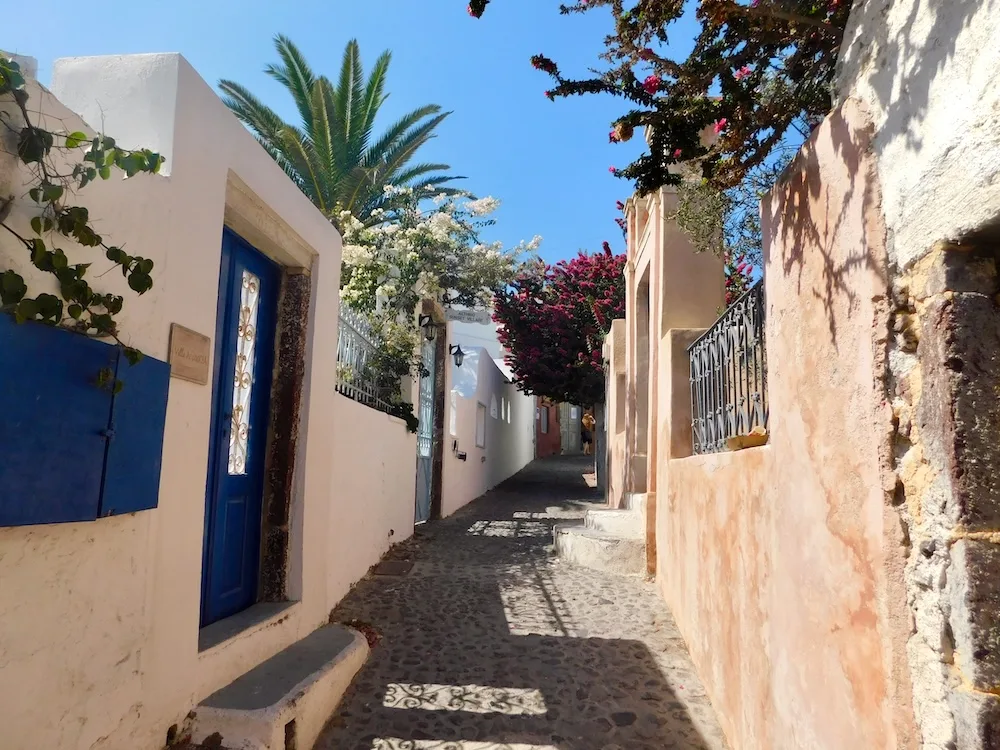
Initially, it was great. We meandered down narrow stone streets, appreciating the contrast of the whitewashed homes with the brightly-colored flowers growing on trees and gates around them. There were several scenic overlooks for admiring the blue roofs and church towers.
We made our way to the far side and hoped to wander in and out of the stores on our way back. But by 11:15 the town was crammed with tour groups way too big for its narrow streets.
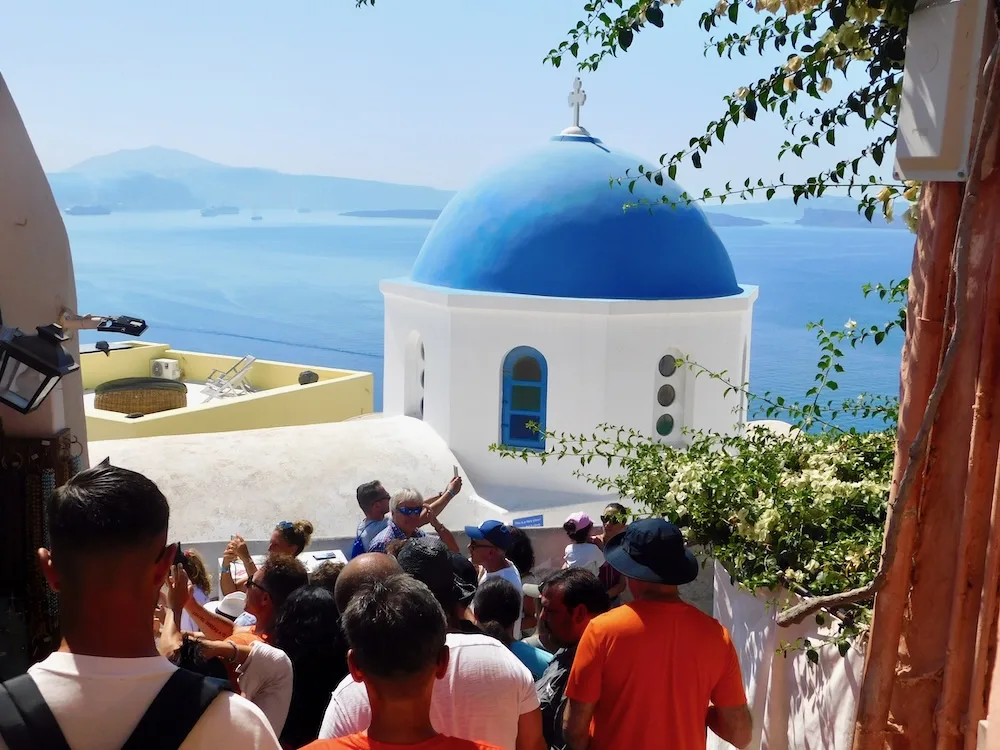
Pushing through the steady crowd wasn’t enjoyable and shopping was impossible. We used some less crowded side streets to get back to our driver and happily left Oia and its crowds behind.
Try your best to get to Oia by about 10:00; the earlier, the better. Or if your ship has a later return time, visit at the end of the day, when most cruise passengers are heading back to the port.
Pretty, Empty Pyrgos
We were running short on time by the time we got to Pyrgos, our last stop, and this was unfortunate. Not many tourists find their way there. It feels like a real town where local people live, while still being charming.
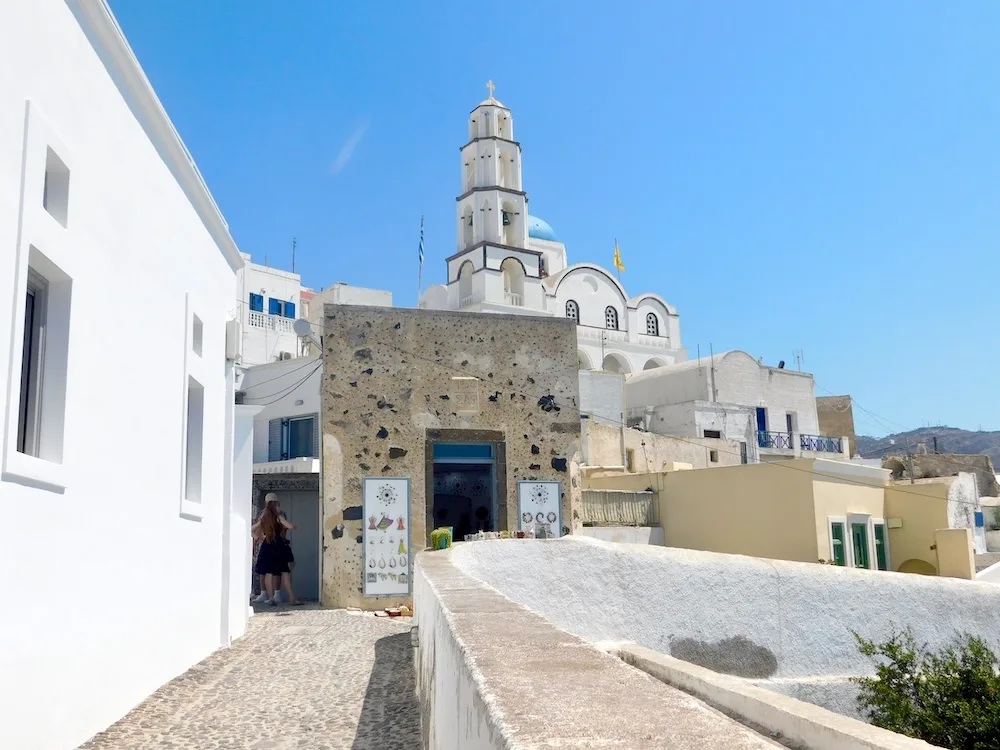
There is a Spanish fort at the top that we only had time to peek at. On the way up and down we wandered little streets where we were alone and had room to appreciate nice tile work, an intricate gate or pretty flowers in front of the various homes and to admire the way houses are built on top of each other into the mountain.
There were a couple of restaurants on the main road that looked promising and busy but not packed.
Pausing at The Prophet Elias Monastery
Make a point of seeing the Prophet Elias Monastery, pausing on the overlook along the road up to it. The 18th century Cycladic compound has stone patios, cypress trees and pine trees, a few cats wandering around and a small, pretty chapel that’s spare by Greek Orthodox standards.
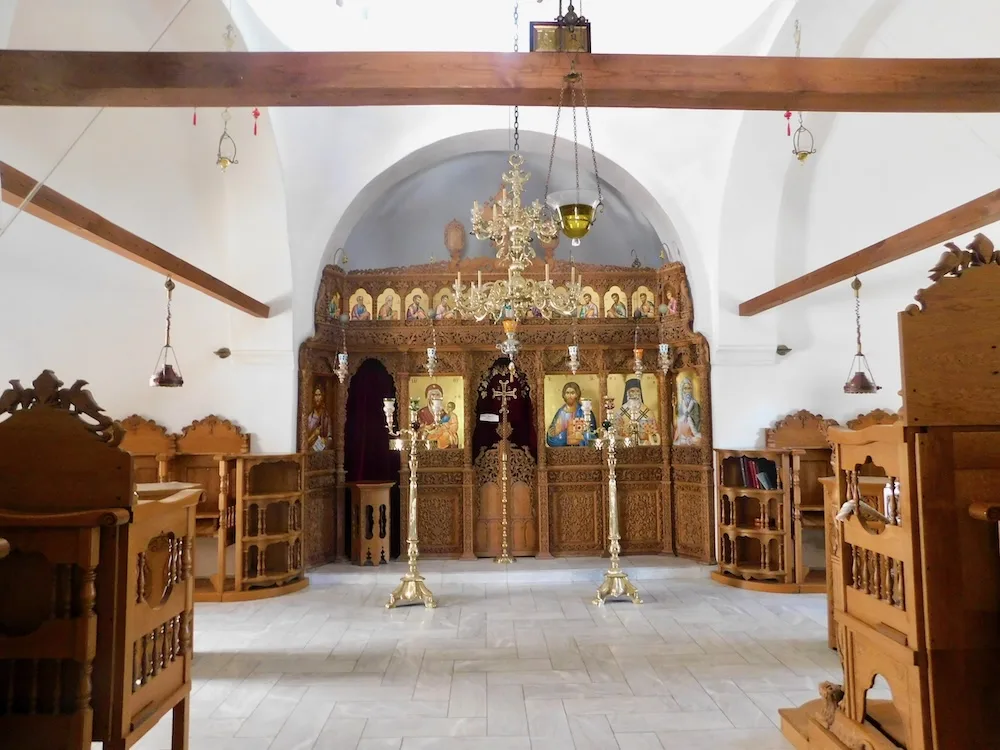
On this hot volcanic island that has a lot of stark brown earth and gray rocks, the monastery felt cool and green. We were all happy to sit for a few minutes and enjoy a pause from the sun and sightseeing.
The main monastery is closed off to the public. But there is a store where you can buy honey, olive soap and other items made by the remaining monks. We bought a blue-roofed chapel for our very eclectic Christmas village. The items are better quality than what you might find in Fira’s tourist shops, and we liked the idea of supporting the monastery.
3 Quick, Fun Stops
We appreciated the value of having our own driver when he took us to a cliff with an overlook on Oia. It was the best vantage point for appreciating its blue roofs and precarious cliff-side perch. And we had it largely all to ourselves.
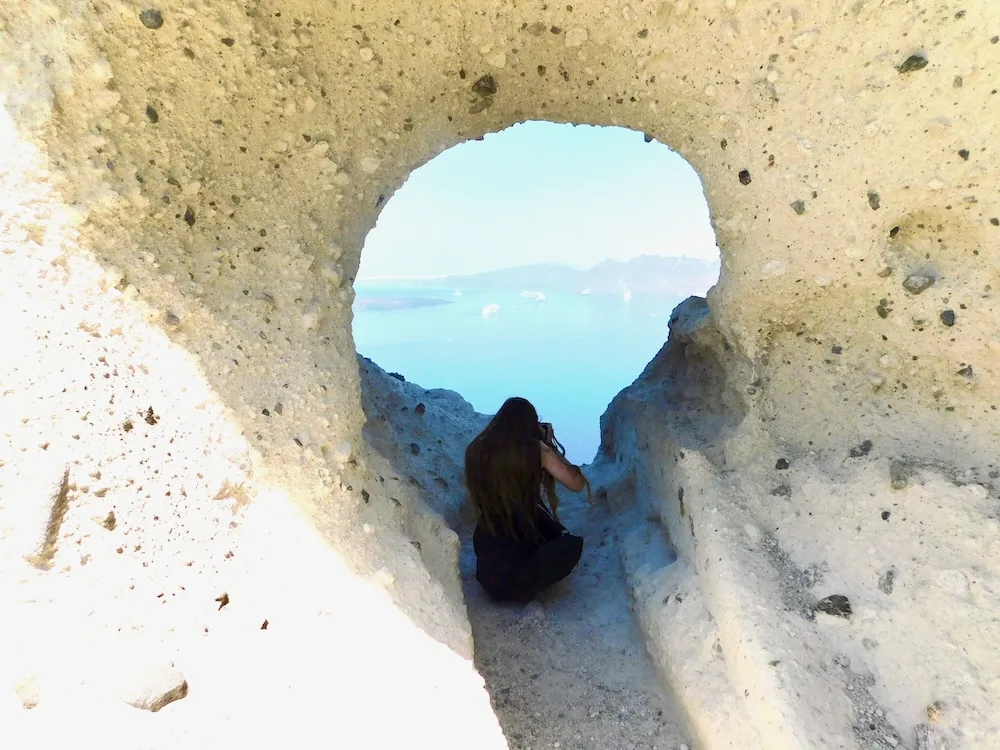
We also stopped at the Heart of Santorini, a place where the wind has carved the stones into walls that are not quite caves. One wall has a hole that’s vaguely heart shaped. You can see Fire through it, and it’s a fun place for photos. There is a small chapel built into the rocks below it, too.
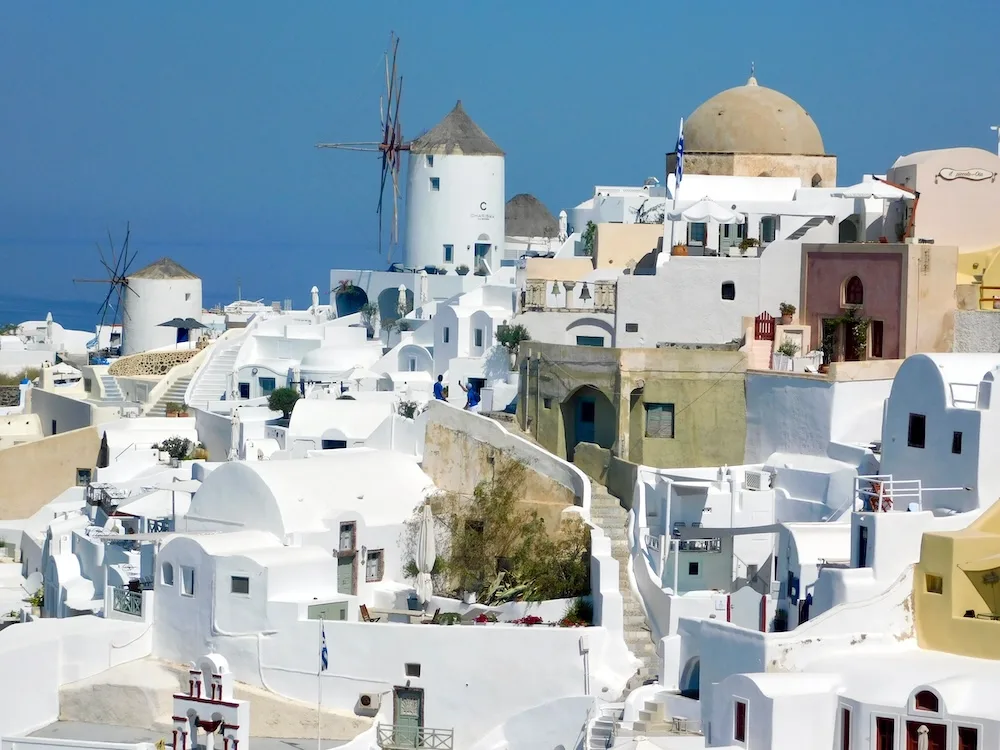
We were also curious about the modern building were either windmills or built to look like windmills. These small flour mills are common on Greek Islands. He stopped at some genuinely old windmills so that we could take a closer look. Teen Traveler jumped at the opportunity to climb around these ruins to take a look inside.
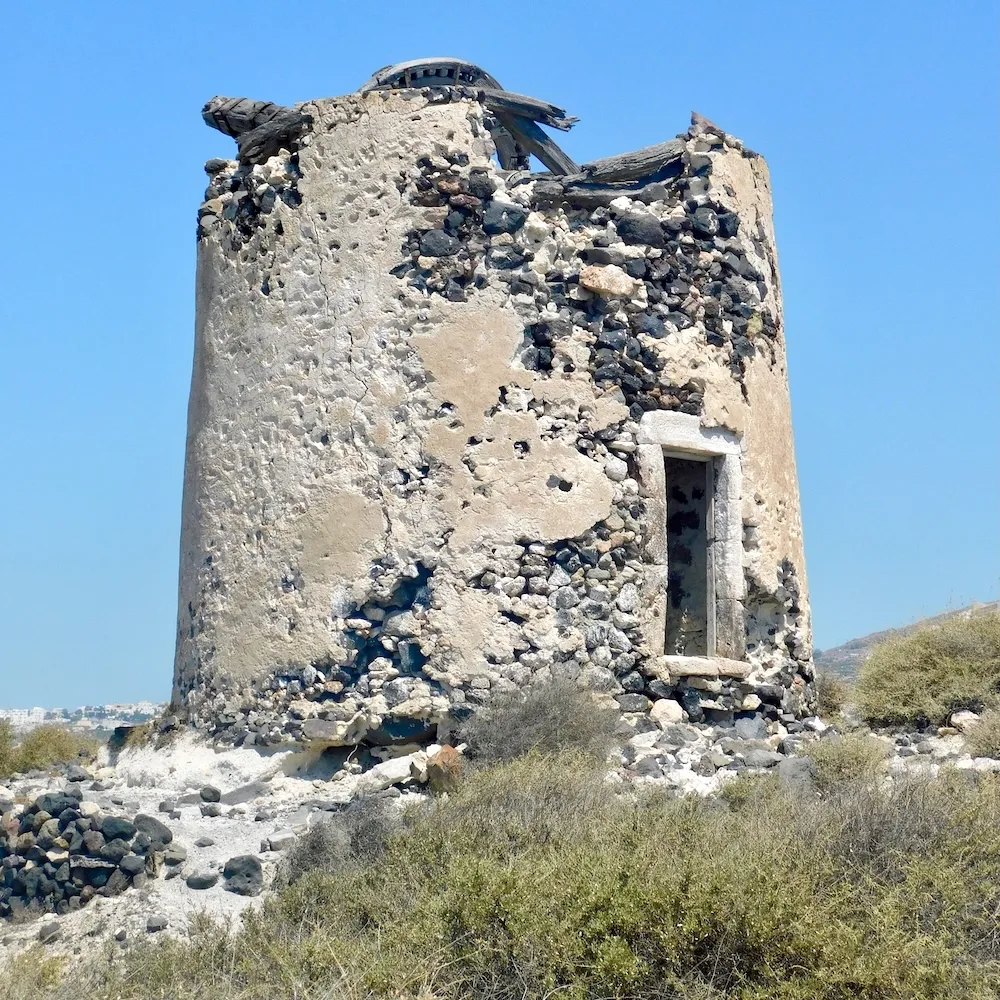
There is real sightseeing on Santorini, including wineries, museums and some archaeological sites. But they didn’t call to us and sometimes there’s something to be said for just wandering around, especially with kids and teens, who can burn out on sightseeing very quickly.
A lot of people head to the island’s black-sand beach. They’re interesting to see if you never have. But the black sand is hot and doesn’t provide the best beach experience. If you check it out, you might plan a shorter stay here than at other beaches.
Shopping on Santorini
We started and ended our day in Fira, the town perched above docks where the cruise-ship tender boats dock. This is where we did most of our shopping.
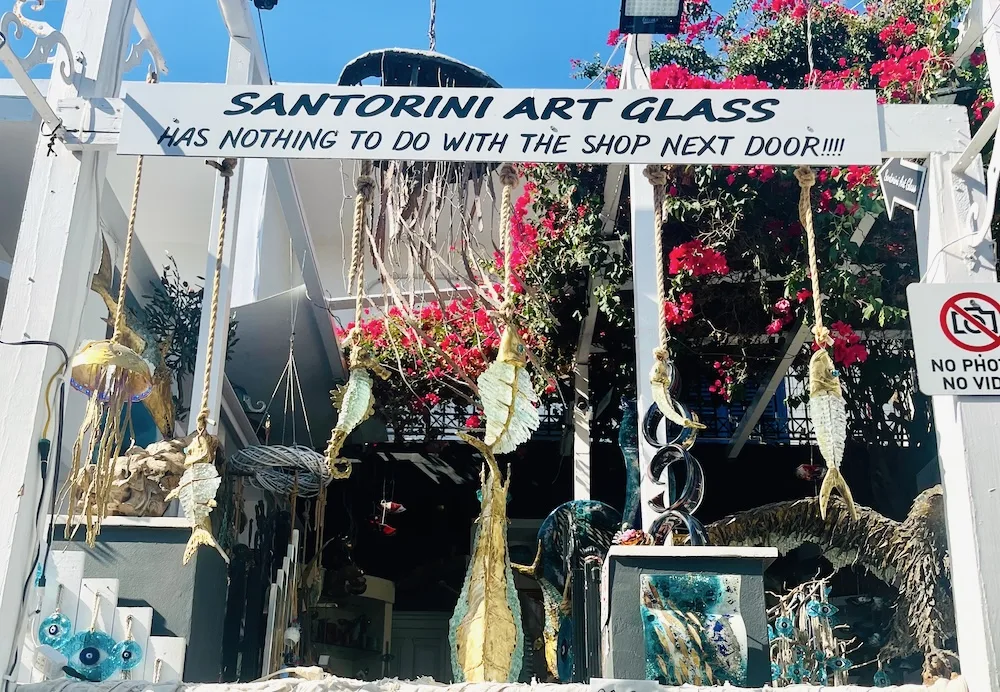
Our best find was a Santorini Art glass, a studio and shop owned by a husband-and-wife team. Their creations combine her metal work and his glassmaking, and they’re unique and lovely. I’d have loved to have taken home one of their larger, more ornate pieces, but budget and practicality pushed me toward a tiny Mediterranean fish that we love.
Note that there is a Murano glass store next to this studio. It’s pretty but not the least bit Greek. Wait to go to Venice to buy it.
Rich bought a Mediterranean-style light cotton shirt that he could wear on the rest of the trip. I bought bars of olive-oil soap in pretty sacks for presents.
If you want handmade Greek sandals, head to Sandalopoieio. They have several inexpensive, fun styles and this is one of those souvenirs you’ll actually use.
There are several upscale jewelry stores tucked between the tchotchke shops, too, if that’s your thing.
Greek Food at Santorini Restaurants
With everyone coming and going through Fira, it’s a busy place. But the town sprawls a bit and as you get further from the cable car, the crowds thin. Our driver dropped us in a different spot from where he picked us up so that we could walk through on our way back.
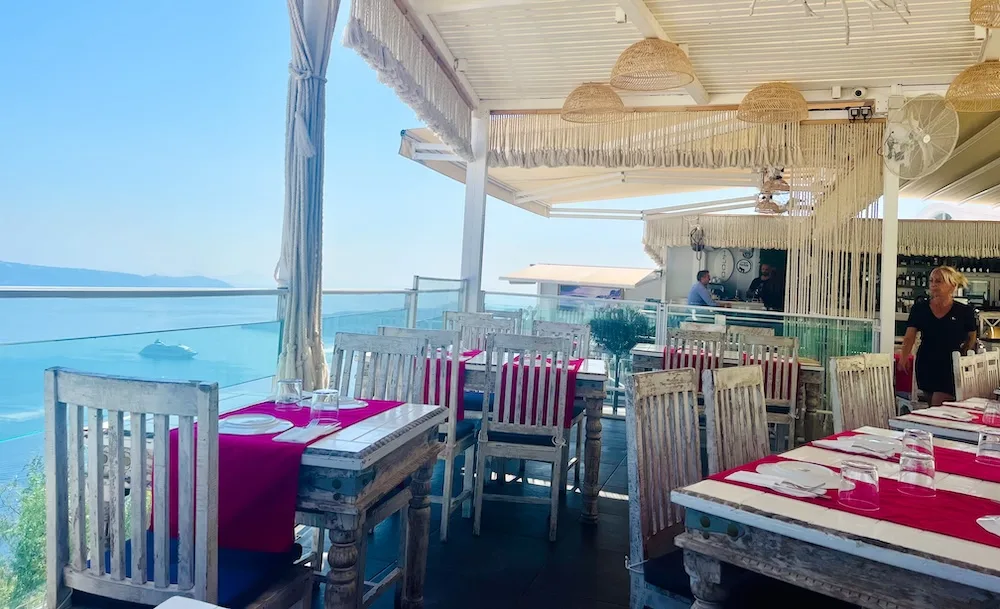
Lunch: We had a light, late lunch at 1500 BC, which was quiet and had a lovely shaded patio with a view that probably would have been breathtaking at sunset.
We shared a selection of mezze, including fried calamari, grilled squid, a bowl of olives, tzatziki with fresh pita bread and French fries.
The seafood was fresh and the Octopus was nicely chewy. The tzatziki was light on the garlic and flavored with lemon and mint. The fries were sprinkled with salt and oregano. It was the perfect first meal in Greece.
With two glasses of crisp, local white wine and a lemon soda, the tab came in under €80, which is not bad at all for a restaurant with a view in a tourist town.
Drinks: As soon as our driver dropped us off, we stopped into LuxBar because we were really thirsty and it was the first place we came across that looked interesting. It has a DJ and quite a scene at night, but in the afternoon it was a quiet and friendly place to enjoy cold beers and lemon soda.
The food looked good, especially the hamburgers other people were ordering. But it wasn’t especially Greek, so we enjoyed our cold drinks and moved on to 1500 BC.
Bakery: While waiting for our driver, we stopped into Svoronos bakery to get snacks for the day. It’s big and a good place to see a wider range of Greek breads and sweets.
Teen Traveler got a chewy Greek bagel and I got a slice of nuts, seeds and dried fruit held together with honey. It sounds too healthy to be good, but it was chewy, nutty and not too sweet.
Gelato: There’s no shortage of places to buy ice cream and gelato in Fira. We found Vero Latte just down the street from the cable car line, and it was a good choice. They had distinctly Greek flavors, like coffee and cardamom, yogurt, baklava and rice pudding.
Teen Traveler mixed scoops of rich chocolate and Italian hazelnut. I went with almond-saffron because it was new to me. It was creamy and delicious, especially if you like your desserts not-too-sweet.
Getting to and from Santorini
Santorini is a tender port, which means you take a small boat between your cruise ship and the island. The majority of people tender to docks below Fira, which isn’t accessible by road.
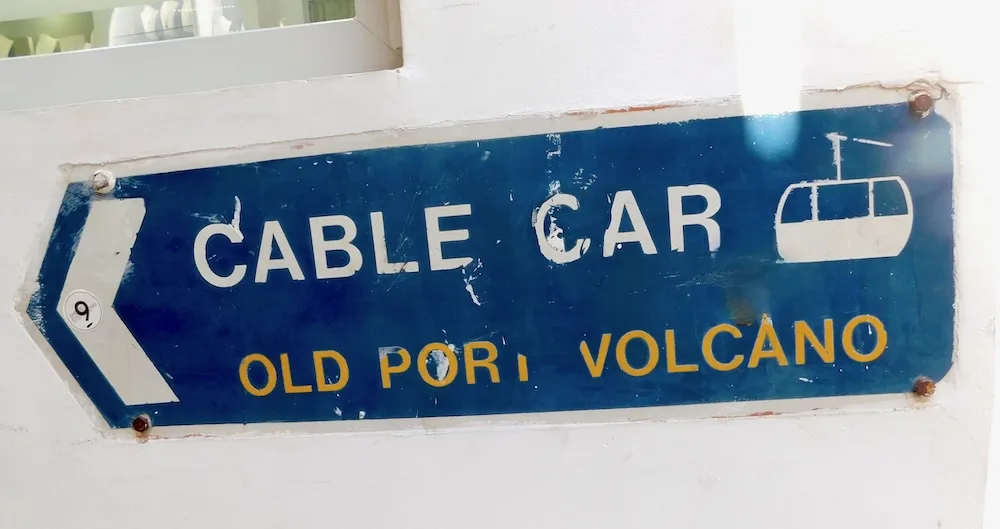
To do anything, including join tours or catch buses and taxis, you need to get to the town either by cable cars or by walking or riding a donkey up 580 marble steps.
The cable car is, of course, the easiest and safest option. The hitch is that morning the Oosterdam was one of five ships in port the day we were there.
The gondolas load six people per car in constant succession, so the line moves steadily, but with several thousand ship passengers coming ashore and leaving at roughly the same time, the lines can get long. A two-hour wait isn’t unheard of in the afternoon.
We had an early breakfast, lined up for the tender as soon as we could and wer on the line at 9:00. We were sitting in a gondola about 15 minutes later.
Our ship had a 7:30 pm departure time, later than the other ships. So in the afternoon we lined up around 5:00, when most of the other people were gone, and we waited a half hour. Not bad.
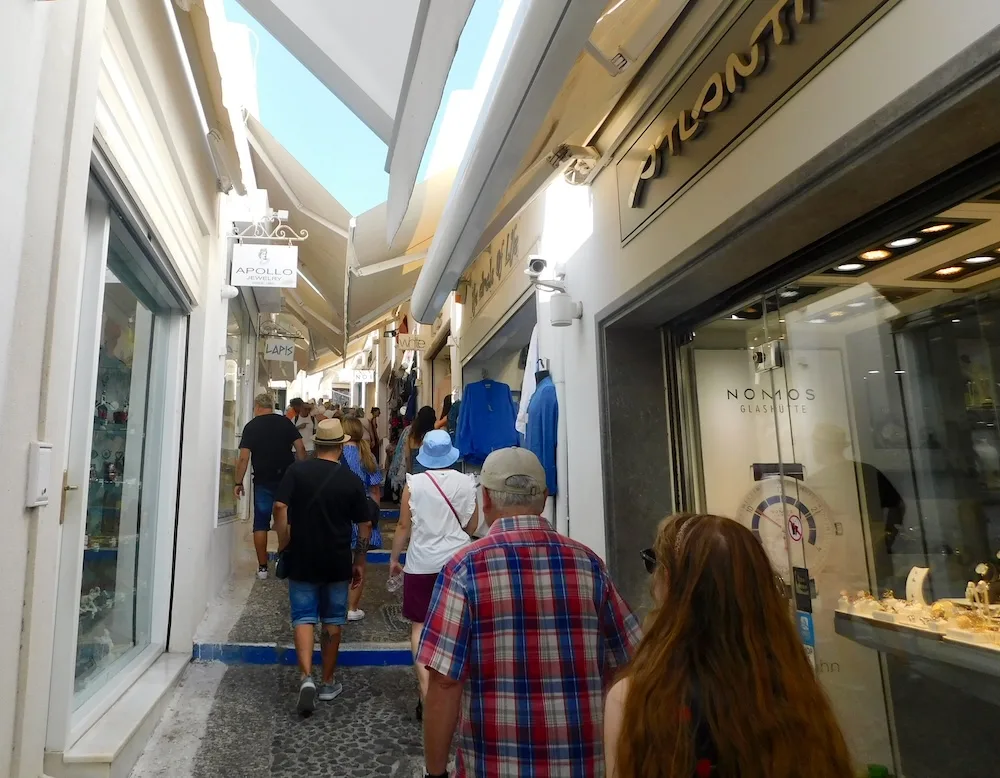
Rich held our place in the afternoon line while Teen Traveler and I got gelato for the three of us. I recommend buying cold soft drinks, cocktails to-go, ice cream or gelato from any of the many vendors near the cable car line. It passes the time and keeps you cool.
Keep in mind that the morning line is mostly in the sun and the afternoon line is largely shaded but hot. This is where people get sunburns and heat stroke. So wear a hat, put on sunscreen and stay hydrated while you wait.
Thinking about walking? The steps to the top are slanted with the hill and extremely slippery. They’re also dotted with donkey droppings and hay that blow around in the wind. Moreover, the donkeys are oblivious to pedestrians. When they pass, you will be clinging to the side of the steps trying to get out of their way.
Cruise Director Ed tools us that in his experience, going up is a slog and going down is treacherous. Back on board the Oosterdam that afternoon, I heard people who did it say it was okay or manageable. No one said they were glad they did it.
Aside from the considerable ethical issues with riding the donkeys, I’ve been told the ride down is quite scary, and the ride up is slightly less scary. It’s uncomfortable both ways.
The Logistics of Our Cab Ride
This was the only excursion I didn’t book through Holland America. They do have bus tours that approximate what we did, and the cost was comparable to the €260 (plus tip) that we paid.
But having our own driver allowed us to go at our own pace and still see more places. He took us to smaller, out of the way sites and had more flexibility than a bus to avoid traffic jams around the popular towns. He was also full of local knowledge and tips.
He texted me the name and address of a restaurant outside Fira’s pedestrian zone the night before our tour. With the help of WhatsApp we found it and him earlier than originally planned and were on our way.
It’s tempting in this situation to ask a driver to take you to a good local restaurant, but a staffer on the cruise ship pointed out that sitting and eating is not the best use of the driving-around time we’re paying for. So we planned for a late lunch by having a big breakfast and buying snacks along the way.
Tip: All the towns are pedestrian zones with areas for buses and taxis to drop their passengers. Also, all the towns are built into the sides of mountains. Everything is uphill or downhill. Plan to walk and to do a lot of stairs. Wear comfortable shoes. If you have little ones, put them in a carrier or let them walk. A stroller will be useless.
Essential Things To Do & See on Your Rhodes Port Day
Start at the Ruins at Lindos
The Acropolis at Lindos is the main historical attraction on Rhodes. We decided the easiest way to see it was via one of the ship’s group tours. It was the biggest tour we joined on this trip, probably 30 people, which we’re always wary of.
But the guide was knowledgeable, and she gave us ample time to explore the ruins and tiny streets at the foot of the Acropolis on our own.
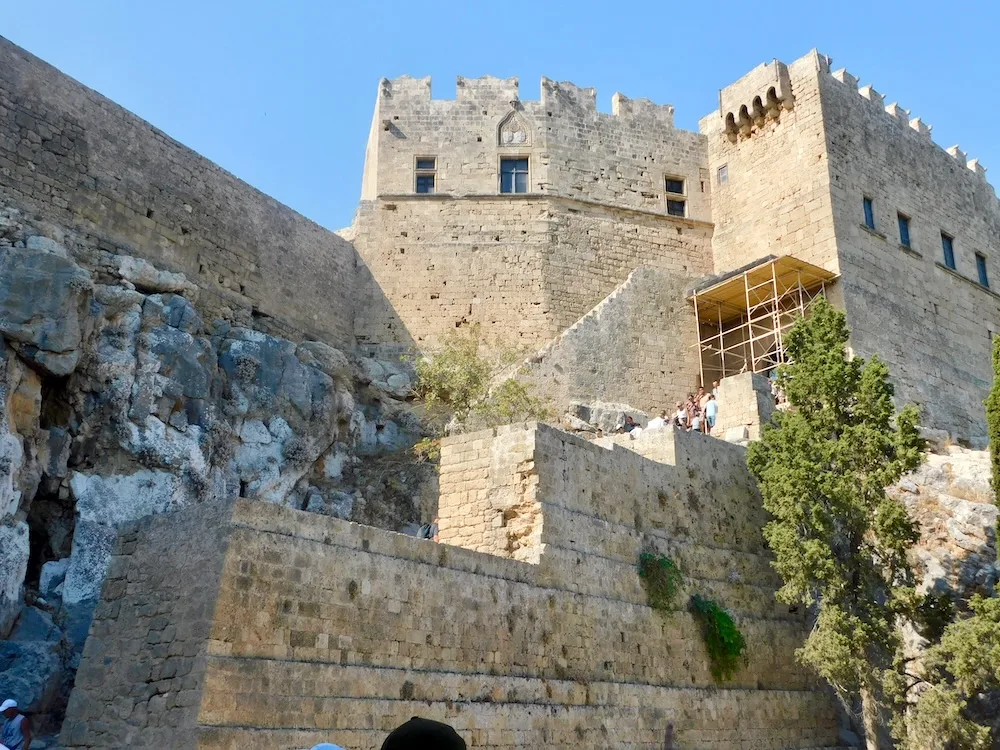
Rhodes has a history that is typical of this part of the world, with a succession of invaders, including the Greeks, Christians, Ottomans and Italians, layering their influence and style over each other.
The Acropolis reflects this with add-ons from several cultures mixed together. But it is a pile of ruins and there isn’t that much to see once the guide stops talking and leaves you on your own.
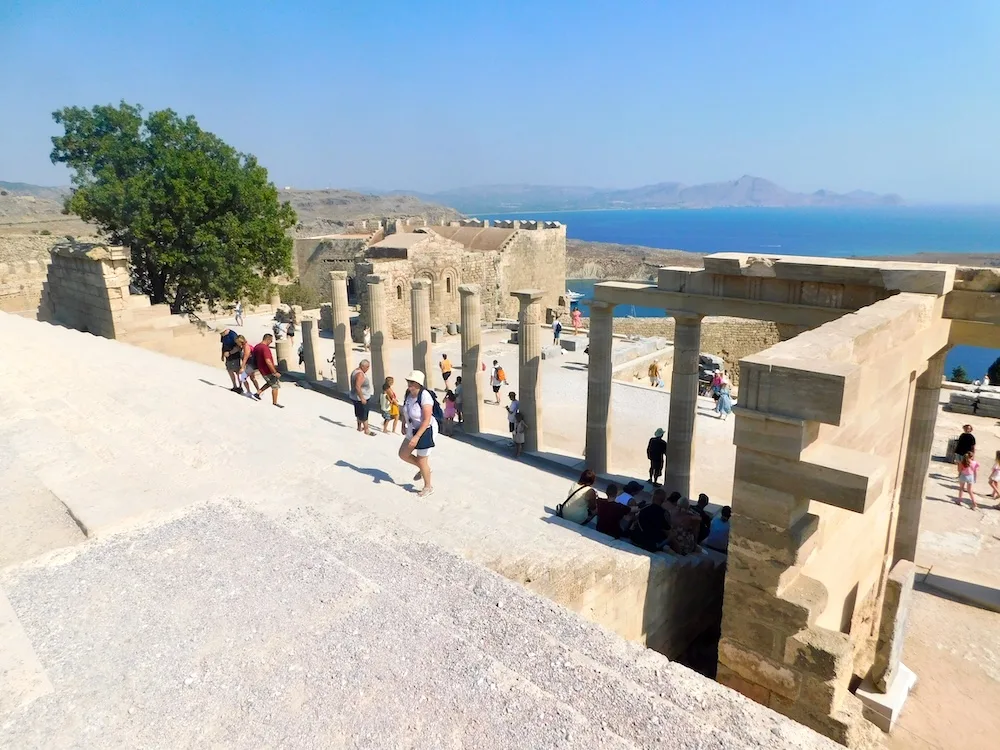
There is a classic Greek temple and a gorgeous ocean view at the very top of the Acropolis. But the white marble reflects and amplifies the sun, making it feel like we were standing in a frying pan. We walked around, took in the views and took photos, but we didn’t linger.
If a sunset tour is an option for you, jump at it. It would be incredibly scenic and a little bit cooler.
There’s a maze of narrow streets at the foot of the Acropolis that are home to art galleries and shops that sell local honey, leather goods and artisan jewelry. Some of what you’ll see is hand-crafted and unique. But needless to say, you won’t find the best prices here.
Lots of vendors sell freshly squeezed orange juice for a couple of Euros. It’s quenching and delicious after the hot walk to the top of the Acropolis and back. Despite it still being morning, Teen Traveler found ice cream. Who could blame her?
Yes, You Want to Visit the Pottery Workshop
Our bus tour included a stop at the Bonis family ceramics workshop and store. The entire bus rolled its collective eyes at what we expected to be a longer stop than we could want at a tchotchke shop.
Fortunately, the owner of this three-generation family-run workshop is incredibly charismatic and knows how to impress a group of tourists.
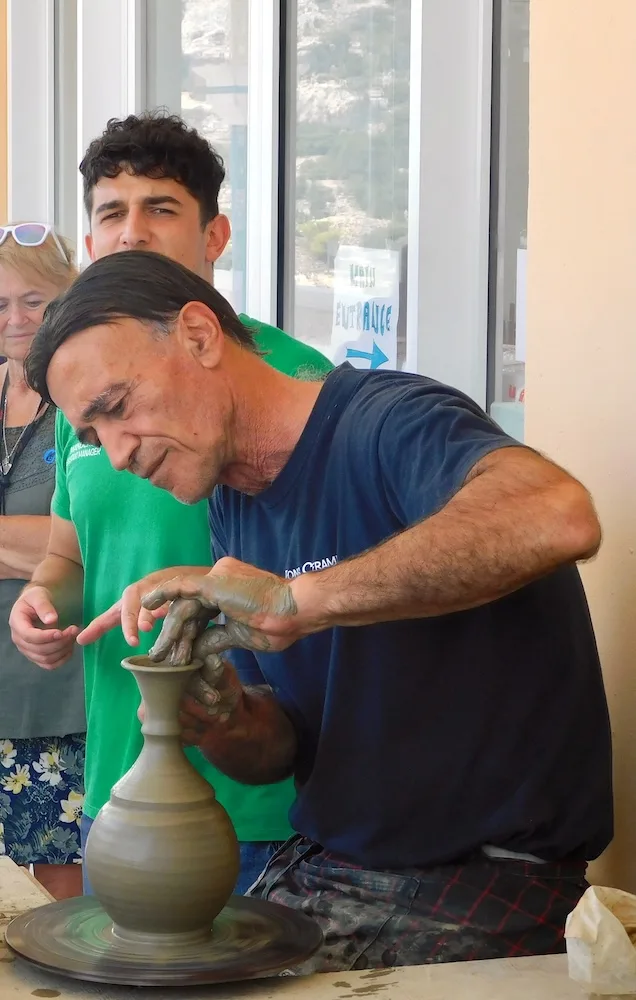
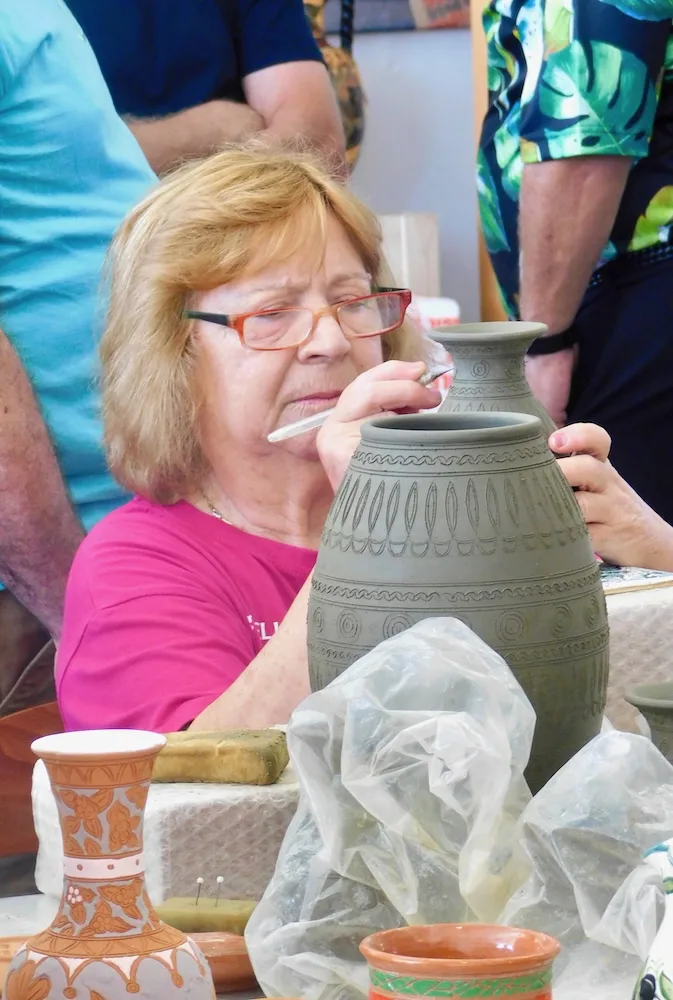
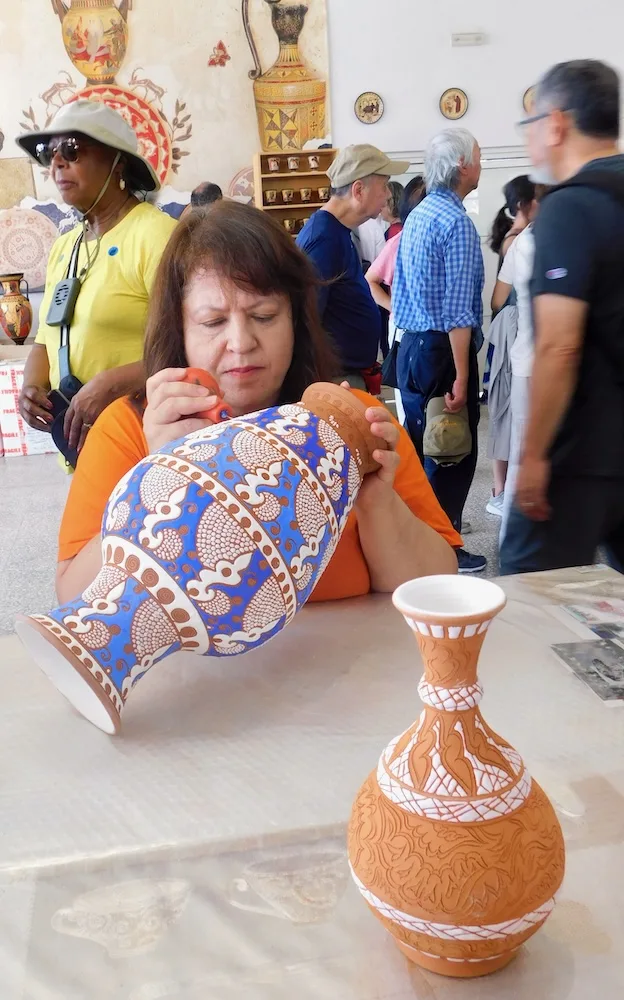
He showed us how the pottery is shaped on a wheel. Then he explained while two women demonstrated how they use needles to etch intricate designs and add color to the pottery before it’s fired.
No two pieces are exactly alike and even the most jaded among us were impressed. Everyone bought something.
The Surprising House of the Grand Master
The House of the Grand Master sits on what was once the site of a fortified, utilitarian monastery that housed the Knights of St. John, warrior-monks who practiced medicine, ran a medieval hospital nearby and crusaded against Muslims in the region. The Grand Master was the head monk.
The Ottomans destroyed the original building. Later, the Italians pushed them out and rebuilt it in the early 20th century to reassert Christianity.
But the Italians built it mostly for show. It fits with the town’s original Medieval structures, but it’s essentially what Hollywood would imagine as a Greek-Island monastery fit for a group of Knights Templar. The stone building has well-preserved mosaic floors, elaborate chandeliers, sea views framed by ornate windows and a lot of heavy wooden furniture.
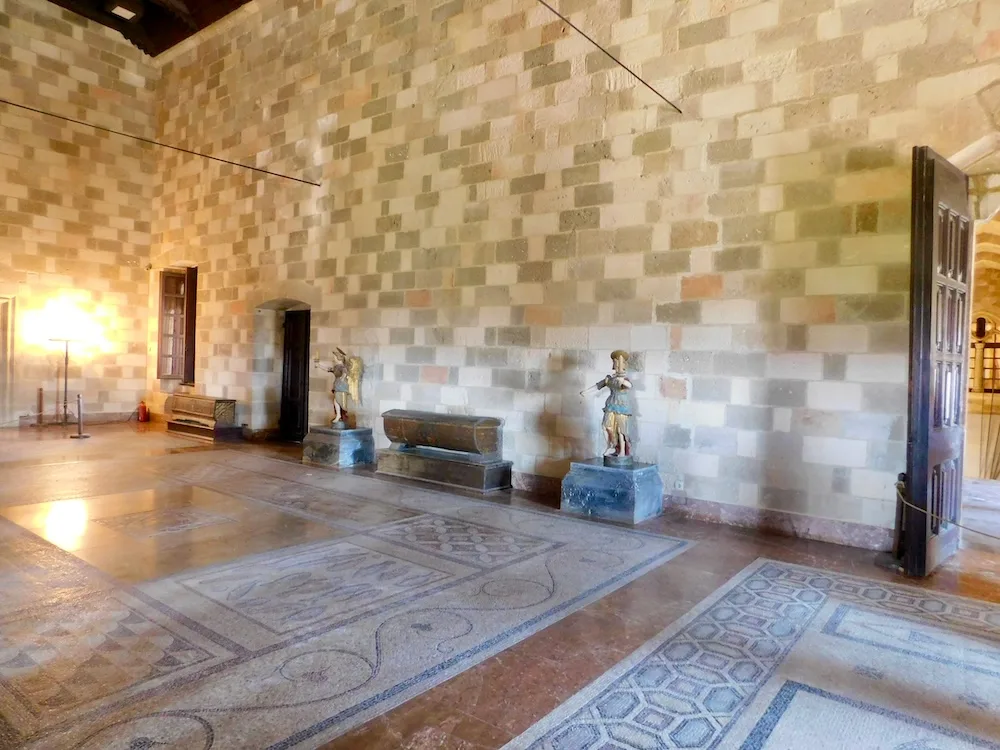
We enjoyed walking through it and appreciating all the superfluous details. From the Grand Master’s House you walk down the dramatically named Street of the Knights of Rhodes. You’ll pass the site of the old hospital and a doorway with a symbol of the warrior monks, which look a lot like a Masonic emblem.
Walking around the Medieval City of Rhodes
Rhodes Old town is full of stone streets and picturesque medieval buildings surrounded by ancient walls. On the far side from the water, the wall widens into a tree-lined esplanade that was nice to walk along.
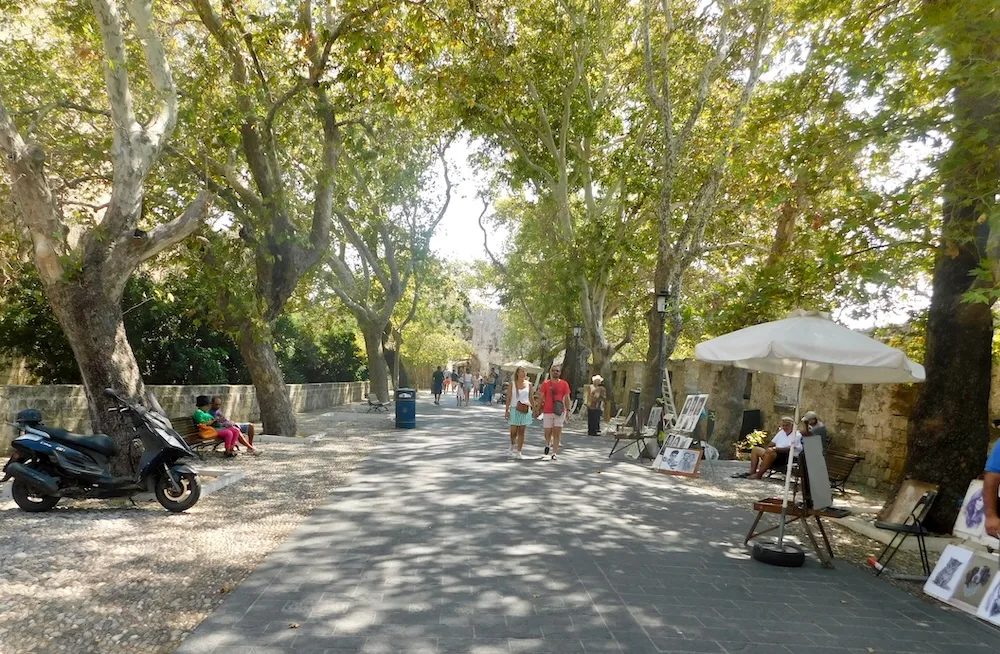
The stores were sold the usual mix of Greek-Island souvenirs, including olive-oil soap, olive-wood bowls, sunhats, cotton shirts and loose, flowing peasant dresses. It was largely a repeat of what we’d seen in Santorini, and we didn’t do any shopping.
The one downside to our tour was that lunch was included. While the hotel buffet we had was good, we would have preferred to go back to town and eat at one of the many cafés with welcoming, shady terraces.
One place really called to us, though, and we stopped for wine and dessert before heading back to the ship.
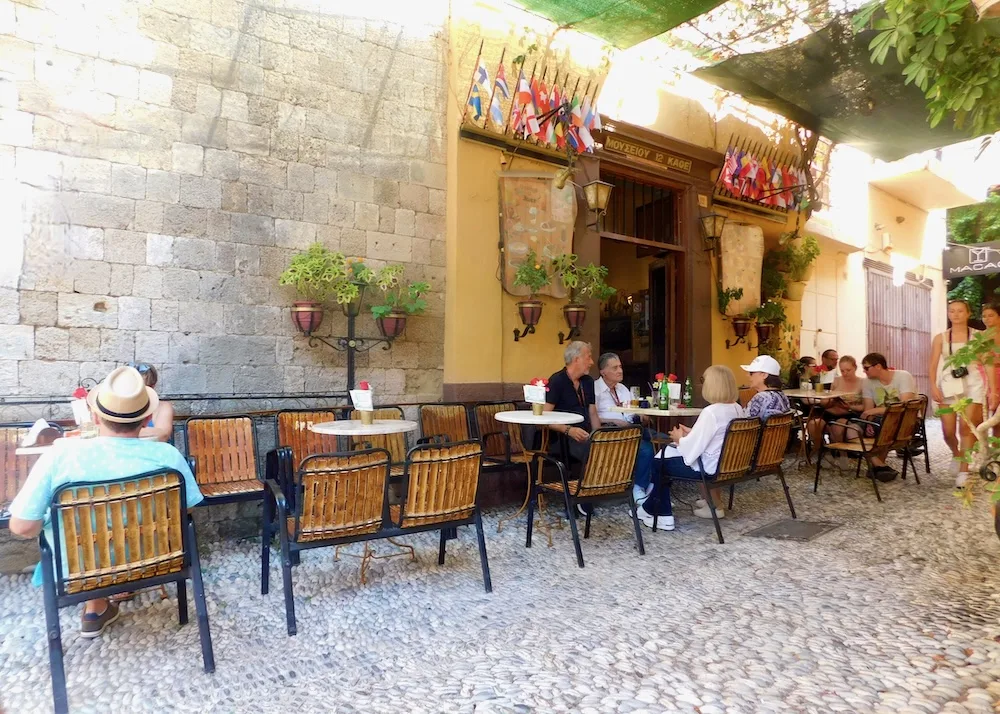
While walking to the sea gate closest to the cruise ship docks, we realized Rhodes Old Town is far bigger than we thought. Unfortunately, by then we were short on time, I had blisters on both feet and the ship’s pool was calling.
Had we realized sooner how much more there was, we would have spent less time wandering in the little corner of town near the Knights Road. We could have taken photos of the magical looking Fountain of Hippocrates, climbed a clock tower for rooftop views of the town and explored the pretty 16th-century synagogue and two medieval mosques.
There is also a small seahorse fountain that’s worth seeking out in the direction of the synagogue. Beyond it are the ruins of two medieval churches and a pilgrims’ “hostel.” Near these ruins, Dionysus Park has shady paths and a decent playground. It’s handy if you have younger kids who could use some open space to run around and you want a cool place to sit while they do.
When you come down the Street of the Knights of Rhodes, cross the plaza toward the town gate and hang a right toward Hippocrates Square. Continue past and wander the streets. There’s no grid, so a map (Google or paper) is handy to find specific sites.
Getting To and Around Lindos and the Medieval City
The cruise ship dock in Rhodes is just outside the Medieval city. So you can walk off your ship and into town. This was handy for a family we knew traveling with two boys under 8YO. The wandered the town, bought ice cream and returned to the ship easily when the kids inevitably grew hot and cranky.
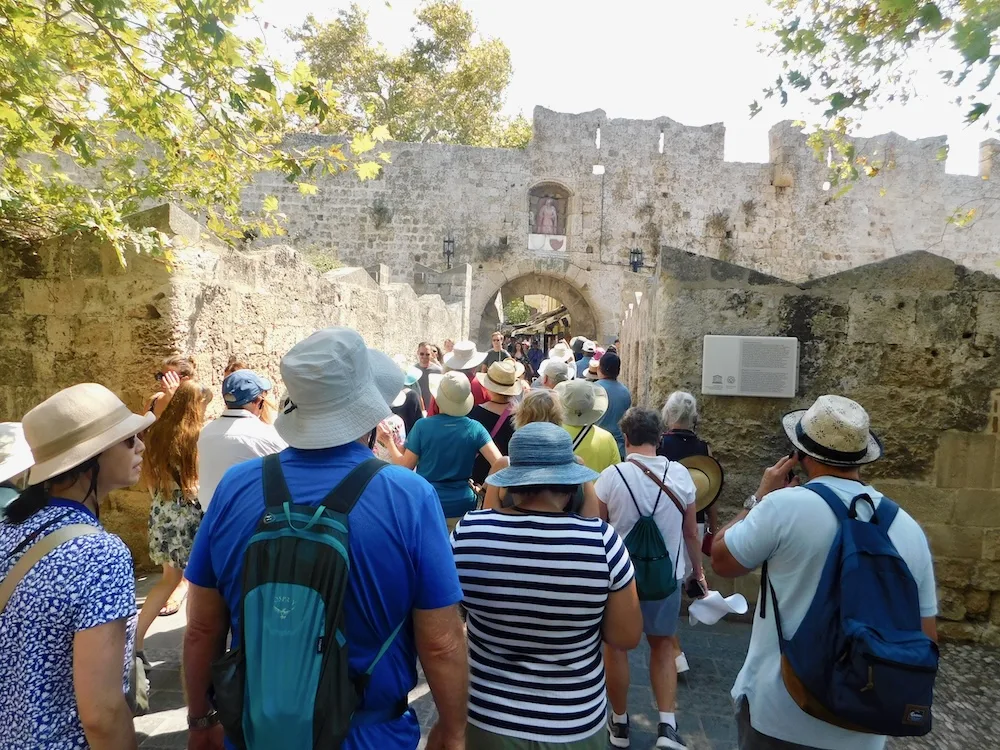
If you want to spend your port day at the beach, you can probably find a taxi to take you to a public beach that’s a reasonable distance. I’d also look into day passes at some of the resorts before you leave.
The Acropolis of Lindos is about a one-hour drive from the cruise port. We arrived just a few weeks after wildfires had driven people from the island. But this wasn’t the part of the island that got the worst of it. Surprisingly, we didn’t see any damage at all.
Our bus followed the coast for part of the drive. Then we passed through some scrubby forests and villages that were more modern than quaint.
You can probably get to the ruins by bus or book a taxi for the day if you want more flexibility than a tour allows. There are bus stations in both Rhodes and Lindos, where you can probably catch a cab to the Acropolis. But I don’t know if you can find a guide on site. And ruins are more interesting when you have someone to tell you about them.
There are 250 steps to the base of the Acropolis. They were very slipper or steep. It took us ten minutes to get from the entrance to the village to the top, and it felt like easy going compared to other walks we did on this trip.
There was also a set of about 20 stairs to the top of the ruins that are more slippery, have no handrail and have a foot-wide gap between the steps and the wall. Stick to the middle. If you use walking sticks at all, you’ll find them handy and easy on this excursion.
Our tour guide gave us the option of stopping at the site where they believe the Colossus or Rhodes once stood. But the consensus was not to. There isn’t even a tiny remnant of the giant statue there, so why bother?
Rhodes & Santorini Port Days: In Short
We would go back to both Santorini and Rhodes.
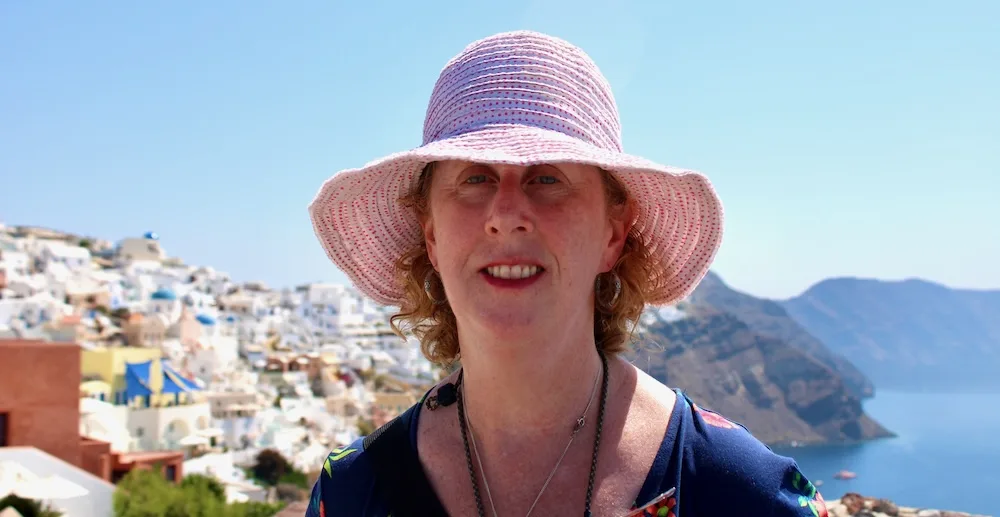
Staying on Santorini would give us the opportunity to sample its beaches and wineries and more of its fresh seafood. And I’d like to explore the towns in the off hours when they’re less busy.
Rhodes is bigger, and we feel like we just scratched the surface. I’d go back here for the beaches, too, and also to explore the Medieval city and the rest of the island more thoroughly.
Practical Tips for Port Days on Rhodes & Santorini
Weather & Clothes on Santorini & Greece: Do not underestimate the summer heat and sun on these islands. Wear hats and sunscreen and seek out shade as much as possible. I wore summer-weight long-sleeve tops on these stops. I wasn’t hotter than on days when I wore tank tops, and being less exposed to the sun’s rays helped.
Carry water, stop for cold drinks and food. And eat as much ice cream and gelato as you want. This goes double for kids. The portions are typically small. And for most kids, too much sugar will be less of an issue than too much heat.
Communication on Port Days: We were able to use WhatsApp to communicate with tour guides and each other on our port days because I bought Airalo eSIMs for Greece before we left.
The $5 virtual SIM cards each had 1 GB of data that was good for seven days from activation. We activated them the morning we arrived on Santorini, our first Greek stop, and it lasted us through Rhodes and Greece.
Footwear: I thought it would be cooler to wear my canvas sneakers without socks on Rhodes, but feet expanded in the heat and I wound up with painful blisters on both feet, which stinks when you have one day to explore a place and want to make the most of it.
For the rest of the trip I alternated between Taos and Skechers sandals that had the cushioning and good non-skid soles you need to explore the marble ruins and walk on stone streets.
Print the Packing List
Pin it for later!
